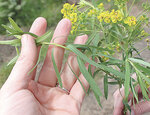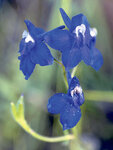Mostly Cloudy, 39° F
County officials are hunting for leafy spurge and other troublesome noxious weeds and looking to the skies to aid their search.
Park County Weed and Pest has contracted with Powell’s GT …
This item is available in full to subscribers.
The Powell Tribune has expanded its online content. To continue reading, you will need to either log in to your subscriber account, or purchase a subscription.
If you are a current print subscriber, you can set up a free web account by clicking here.
If you already have a web account, but need to reset it, you can do so by clicking here.
If you would like to purchase a subscription click here.
Please log in to continue |
|


County officials are hunting for leafy spurge and other troublesome noxious weeds and looking to the skies to aid their search.
Park County Weed and Pest has contracted with Powell’s GT Aeronautics to use fixed-wing unmanned aerial vehicles to find the weed in the North Fork, making the process of eradicating the enemy much more efficient. They previously searched the area by foot or on horseback.
“It’s covering lots of ground over a very short period of time,” said Thomas Rullman, president and CEO of the company headquartered in a hangar at the Powell Municipal Airport.
The process allows the pilot to focus on flying the UAV while researchers can have multiple eyes on the images coming in, which increases the chance they’ll spot whatever they’re looking for on the ground.
But that’s just one way Park County Weed and Pest is proactively assisting landowners in the fight against 16 persistent and noxious weeds. Invasive plant species have the power to change our habitats, including the agricultural land that sustains Powell and much of Park County, according to officials fighting to control the growing issue.
Standing in the way of invasive species are many local and federal agencies, not the least of which are our local Natural Resources Conservation Service and Park County Weed and Pest. All are joining together this week to bring awareness to the issue that could negatively impact us all.
“It’s time to rally together and amplify our efforts to combat the silent invaders threatening our biodiversity,” said the North American Invasive Species Management Association in a press release announcing the special effort.
Gov. Mark Gordon has proclaimed this week as National Invasive Species Awareness Week to “promote knowledge and understanding of the threats.”
It’s a huge problem already costing the U.S. more than $120 billion annually. Here in Wyoming it threatens to adversely affect our biodiversity, negatively changing natural processes like fires and flooding and impairing transportation systems, water delivery and energy production, Gordon said in his proclamation.
The goal of the awareness week, which was announced back in January, is to share information about invasive species and steps that the community can take to protect the environment and themselves, “whether they are boating, out on a hike or enjoying a picnic in the park,” the Wyoming Weed and Pest Council said.
Here in Park County the fight is real. Park County Weed and Pest Assistant Supervisor Mary McKinney said the district does more than 500 inspections per year in its fight against invasive species.
“I hate to say ‘we’re from the government, and we’re here to help you.’ But that really is our goal,” she said. “Helping landowners, that is what we want to do. And we do want to protect our public lands from the threat of invasive noxious species.”
In Park County, leafy spurge and spotted knapweed are most persistent among the 16 noxious weeds on the county’s list of enemy species.
Any non-native plant species established or that may be established in Wyoming which renders land unfit for agriculture, forestry, livestock, wildlife, or other beneficial uses or that may harm native plant communities can be declared noxious by the Weed and Pest board, according to McKinney.
Also on the Park County list are baby’s breath, blue mustard, bull thistle, chicory, dame’s rocket, multiple species of larkspur, hoary alyssum, lanceleaf sage, redstem filaree, showy milkweed, sulphur cinquefoil, white campion, wild four o’clock and wild licorice. The emerald ash borer is the only non-plant species on the list.
However, absent from the list but still a huge concern in Park County is cheatgrass.
“If you have [cheatgrass] listed, that means that you then are required to have programs for all the landowners that are dealing with it — which involves resources like money,” McKinney said. “It would break our budget.”
For example, it would be cost prohibitive to eliminate every single cheatgrass seed out of area certified grass seed production, McKinney said.
“We have a lot of grass seed producers on Heart Mountain,” she said. “It would be very detrimental to them.”
McKinney works with the county Planning and Zoning department to do noxious weed surveys for all regulated disturbances, like subdivisions and special use permits. The significant increase in subdivisions has Weed and Pest constantly on the road.
“The last several years, especially since COVID hit and everybody’s wanting to get out of the big cities, there’s been a lot of subdividing that’s been happening,” McKinney said.
For every one of the 500 inspections she has done in the past year, she has to return to re-inspect the area after treatment. She said her work has been made easier because most folks in the county want to be a “good neighbor,” when it comes to noxious weed control. But there are some that are simply anti-government and hard to reach.
However, Weed and Pest remains persistent due to the quickly increasing issues with invasives and McKinney points to overlapping resources willing and able to help landowners rid their habitats of invasive species.
The Natural Resources Conservation Service, Bureau of Land Management, Bureau of Reclamation, National Forest Service and many non-governmental organizations all have programs aimed at irradicating noxious weeds.
“If we don’t know the answers, we can certainly point them in the right direction of who they need to ask,” she said. “We work with many entities to make our programs successful.”
Weed and Pest is also working with landowners through cost sharing for perennial grass mixes that will help keep areas where noxious weeds were removed weed free. The best part: Weed and Pest does consultations free of fees.
Recently they’ve been getting the upper hand on noxious weeds, including in the Crandall area with oxeye daisies, an aggressive invasive species.
“It’s not all gloom and doom,” McKinney happily proclaimed.
For more information online: naisma.org for information on National Invasive Species Awareness Week, including a list of available programs, news and future events and educational opportunities, and wyoweed.org for the Wyoming Weed and Pest Council.